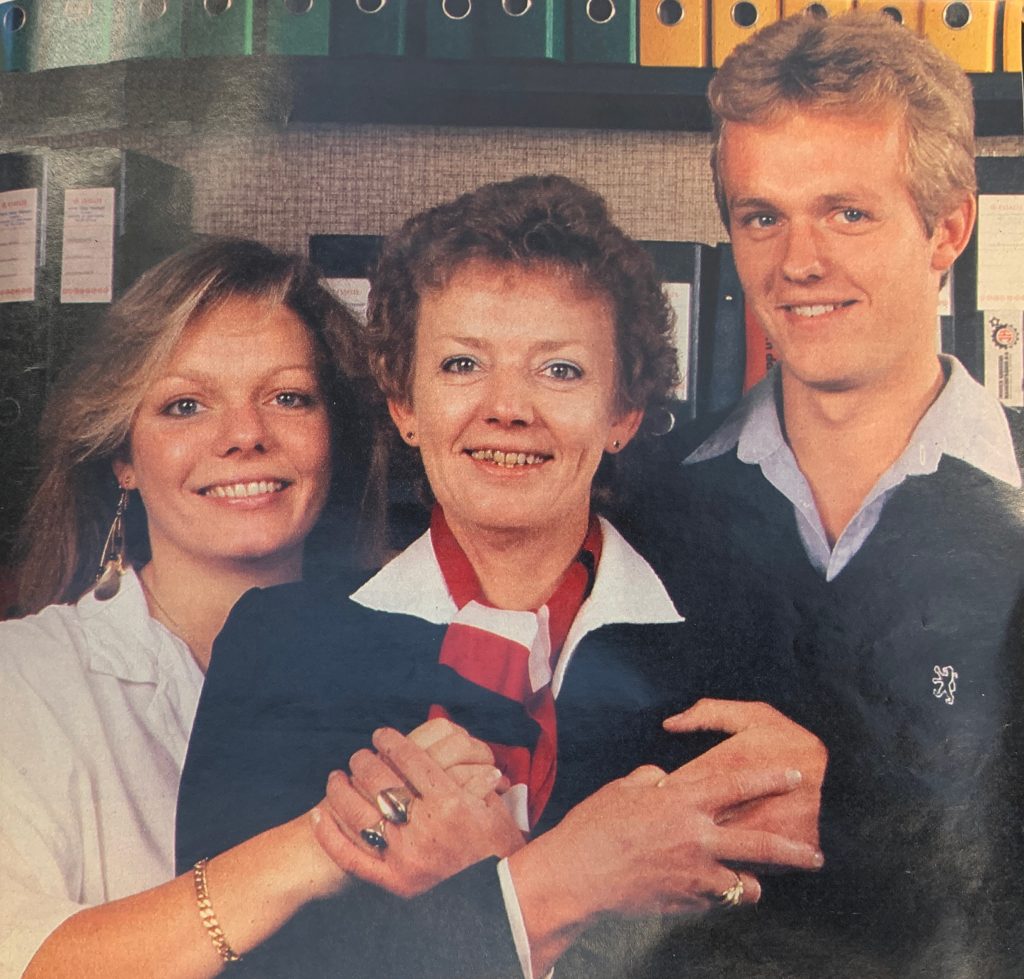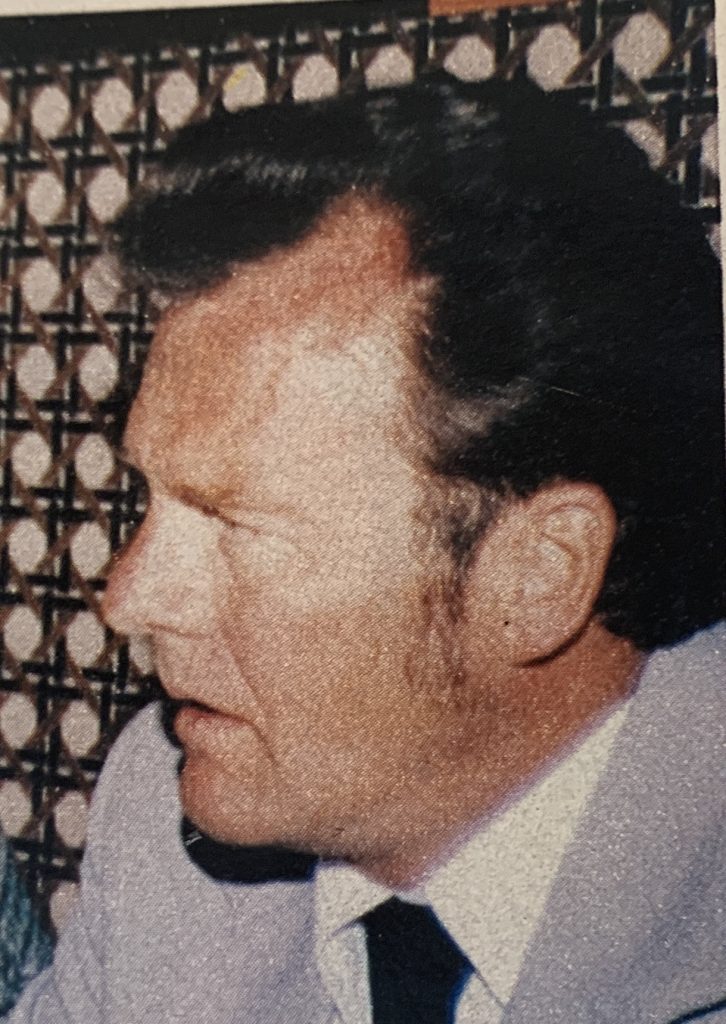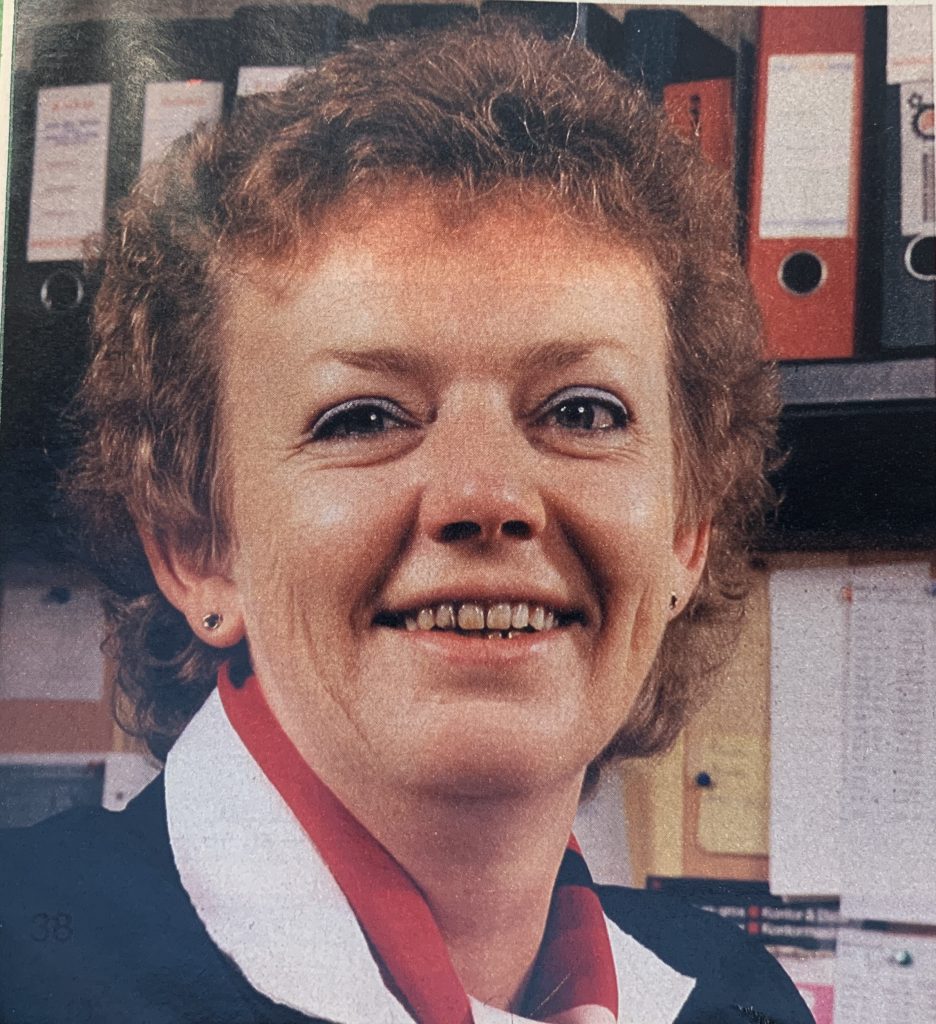WE NEVER GIVE UP
Mary’s whole life was shattered the day her husband, Jørgen Hansen, suddenly died. Now what about the machine factory in Holsted, Denmark, which the two had fought so hard to establish? At that point, Mary made her big decision…
Article by Peter Kjær. Photos by Knud Nielsen. HJEMMET no. 5, 1986 • Translated and reproduced by Moldow A/S, 2022.
The office at Jørgen Hansens Maskinfabrik in Holsted is busy. Mary Hansen, 42, discusses technical problems with her son Preben, 21, while daughter Birgitte, 20, calculates prices for a new order.
But in the midst of the terrific bustle, Mary can suddenly stop and think of Jørgen, who is no longer here. Jørgen, who started it all, when he tested his first big ideas in a garage in Mary’s parents’ garden. When Mary found him lying dead in his bed one morning just over two years ago, 14 days before Jørgen’s 50th birthday, she felt that everything around her stopped.
But still, not many hours passed before she was once again on the path that was always Jørgen’s: To not give up. On the same day that Jørgen died, she decided to continue Jørgen Hansens Maskinfabrik for the sake of the employees, for the sake of the children, for her own sake and not least for Jørgen’s sake. He would have hated the idea that his death had put an end to what he had fought for for a long time.
– Right from the moment Jørgen and I met each other, we were close friends and comrades. We fought together. It was probably the thought of that and our lovely children that gave me the strength. And then of course the thought of our faithful people at the factory. Without their support, it would all be nothing. Mary Hansen smiles.
She was only 40 years old when her husband, who was ten years older, suddenly died, leaving his life’s work to her and the children.
– Jørgen was a trained blacksmith. It all started 25 years ago when he was allowed to build a double garage in my parents’ backyard. Here he tried to put his ideas into practice for the first time, says Mary.
Jørgen Hansen’s first idea was to construct an efficient stone collector that farmers could use to clean their fields. But it did not work out for him.
– However, Jørgen was the type who never gave up, so he got new ideas, which he worked hard to realise, Mary says.

Mary decided to carry on her husband’s lifelong dream, assisted by Birgitte and Preben, who are apprenticed to their mother.
We Created a Success
When she and Jørgen were engaged, she worked as an office apprentice in a grain and feed company in Toftlund in Southern Jutland, Denmark.
– I stopped when we got married. Then I moved home to Holsted and no longer worked for others, because now I had to answer the phone and balance the books. It was easy at that time.
With time, many people saw that Jørgen Hansen was a man who could handle and solve the problems that was presented to him. When people needed a machine for a specific purpose, a machine that had not yet been invented, Jørgen could very often construct it for them.
– Soon, the space in my parents’ garden wasn’t enough, and we bought a shut-down cement factory in 1962, and then we became subcontractors to a lot of other companies.
At first there were only Jørgen and Mary. When Jørgen needed an extra hand at the machines, he called for Mary, and through hard work they got even further, so that they soon had to hire a smith and an unskilled labourer, and then a couple more people.
Mary cut up iron and installed grain drying machines together with Jørgen when she was not busy with the accounts.
– I continued to work with Jørgen in the workshop until I, in 1964, was quite far along in the pregnancy with Preben, our first child.
When Preben was 14 days old, Jørgen Hansens Maskinfabrik moved into the first of the new buildings, which now make up the entire factory, and since then there have been many expansions.
Time and time again, Jørgen Hansen has invented machines for agriculture and industry. More and more employees joined the company, and today around 30 people work at the factory.
Jørgen Becomes Seriously Ill
– Jørgen couldn’t just do nothing. It happened that we lured him on a holiday, but he couldn’t be away for very long. He had to go back home. And when we had time off, he relaxed by making new plans, which he immediately had to go to the factory to test, Mary says.
Jørgen was never sick. But on the evening of May 25, 1983, when Mary was not at home in the house on Østergade in Holsted, he complained to his son Preben that he was in pain, a pain that stretched into his left arm.
Preben called a doctor and got some pills for his father, because Jørgen didn’t want to see a doctor until the next day. Preben went to get the painkillers for his father, who then went to bed.
– I woke up the next morning at 6:00, because we have always gotten up early to go to the factory. In addition, I had to wake up Preben, who his last examination in high school that day, Mary explains.
– When I woke up, I looked at Jørgen. I thought he looked so cold, so I wanted to put the duvet over him. But I couldn’t hear him breathing. I immediately had the feeling that Jørgen was dead, but still I couldn’t understand it, it was so unreal, it couldn’t happen all of a sudden like this.
Mary hurried to call her little brother: “Come over here, I think Jørgen is dead, but I still don’t believe it”.
Mary carefully closed the door to Preben’s room. Daughter Birgitte was in the USA. But Preben still heard his mother, and when Mary’s younger brother, Lars, had arrived, Preben got up and then found out that his father had died during the night.
– It was a big shock and completely incomprehensible. However, it is incredible that you are able to act so effectively in that situation. Preben decided to take the exam anyway, even though he was shaken. It was completely in Jørgen’s spirit, because life goes on. By the way, Preben did well. And then I had to call Birgitte in the USA.

Jørgen worked hard for his company and his family – but suddenly it was over.
Will You Help Me?
When the employees at the factory heard that Jørgen had died, they were as shocked as the family. They could not work that day, but went home.
The next day, Mary gathered the employees at the factory. During the night she had thought it all through, and she had come to the conclusion that although it was very difficult now, she should carry on the factory. After all, many jobs were at stake, and since both Preben and Birgitte had talked about maybe wanting to join the company one day, Mary also felt that she should take the heavy responsibility on her shoulders for the sake of her children’s future.
When all the employees were gathered in one of the production halls, Mary said to them: “I would like to try to carry on Jørgen’s life’s work. But I can only if you want to support me. Are you in?”
A firm yes was heard from all the employees. It came out as spoken with one mouth.
With Jørgen in mind, everyone tackled the big task. Everyone gave a little more of themselves, both the employees, Mary and Preben, who apprenticed in his mother’s office at the same time that he became a kind of foreman.
After Jørgen’s funeral, Birgitte returned to the States to finish school. She has now returned home to Denmark, has passed the business school exam, and now she has also apprenticed with her mother.
– I have had invaluable support from my children and my employees during the difficult time after I was left alone. And I think that Jørgen would say that we have managed well. We have preserved the jobs and our turnover, and we are still making progress, Mary smiles in her own quiet way. She is not the type to use big arm movements.
Mary is not alone in the large house on Østergade in Holsted, where she, together with Jørgen and the children, created the framework for a good family life characterized by togetherness.
She is not alone, because Preben and Birgitte have moved back in. Here too, all three of them help each other, almost as if in a large collective. It is probably not so much the traditional mother-child relationship.
– I feel that we are comrades, very close friends who have managed a great challenge together, says Mary Hansen.

The grief and the struggle to carry on the company have made my children and me close friends, says Mary.